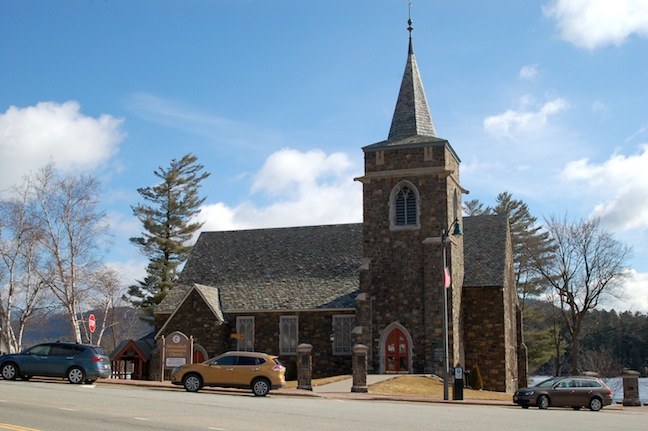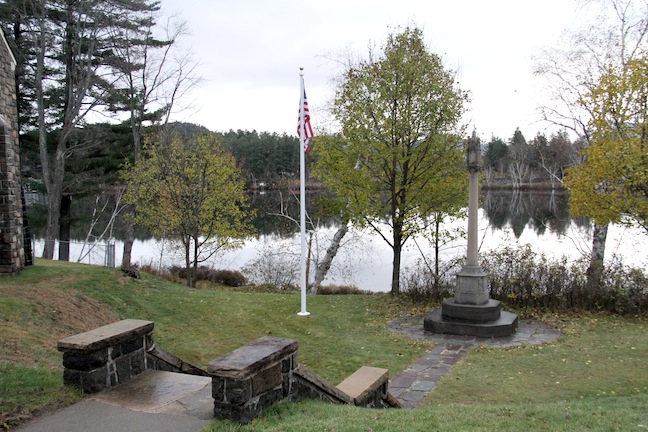A ‘history of God’s faithfulness’ … in 50 pages
New book explores history of Lake Placid’s iconic Adirondack Community Church
- From left, Beverley Reid and Claire Thayer are seen in December 2020. They co-wrote a history book on the Adirondack Community Church in Lake Placid. (Photo provided)
- The stone Adirondack Community Church on Main Street, Lake Placid, was dedicated in 1927. (News photo — Andy Flynn)
- The Benson Memorial Cross, a World War I memorial on the grounds of the Adirondack Community Church on Main Street, Lake Placid, was dedicated in 1929. (News photo — Andy Flynn)

The stone Adirondack Community Church on Main Street, Lake Placid, was dedicated in 1927. (News photo — Andy Flynn)
LAKE PLACID — Beverley Reid’s history with the Adirondack Community Church on Main Street goes way back — 88 years — to the time she was baptized on Feb. 26, 1933, one year after the III Olympic Winter Games came to town. Now she’s helped write the history of the church with fellow parishioner Claire Thayer.
Reid was the natural choice to help with the 50-page history book. She is, after all, the official historian for the village of Lake Placid and town of North Elba, taking over from Mary MacKenzie in 2001.
“When I started as the historian, Mary MacKenzie had a wonderful file about the church, and I have been a member of the church all my life,” Reid said. She turned 88 on Jan. 16.
“I just sit here and shake my head. I don’t know how I got so old,” Reid quipped on Feb. 2.
Not nearly as old as the current stone United Methodist Church or the wooden one it replaced in 1920s or the congregations in town in the early 1800s.

From left, Beverley Reid and Claire Thayer are seen in December 2020. They co-wrote a history book on the Adirondack Community Church in Lake Placid. (Photo provided)
“In 1839,” the book states, “after years of dedicated work by Samuel Smith, a town circuit known as the Saranac Mission was established and serviced by traveling ministers in the North Country.”
North Elba was one stop along the circuit, which included Saranac Lake, Harrietstown, Vermontville, Bloomingdale, Union Falls and Franklin Falls.
“The travel was rugged and the missionaries’ horseback journeys were difficult and discouraging,” the book states.
North Elba shared a preacher with Saranac Lake and Harrietstown when the territory was divided in 1871.
It wasn’t until 1888 that the first church was built where the Adirondack Community Church now stands on the shore of Mirror Lake. Constructed by Myron Brewster, it was dedicated in August 1888. It was called the First Methodist Episcopal Church of North Elba, and both Methodist and Episcopal services were held there, as well as Jewish services under Rabbi Steven S. Wise.

The Benson Memorial Cross, a World War I memorial on the grounds of the Adirondack Community Church on Main Street, Lake Placid, was dedicated in 1929. (News photo — Andy Flynn)
Then as the Roaring ’20s roared through this resort town — with the growing popularity of the Lake Placid Club, outdoor recreation in the summer and winter months and second-home ownership on Lake Placid lake — architectural upgrades soon followed. Such was the case with the Adirondack Community Church.
When the Lake Placid News reported in its July 21, 1922 issue that enough funds had been raised for a new church, to replace the wooden one by the following summer, they called it the Adirondack Temple. A subheadline for the story was, “Adapted Gothic structure of blended hues of stone that will add to fame of Lake Placid.”
One of the first jobs was to move the old church to a lot near the school grounds. The News reported on Nov. 2, 1923 that the church was “now on its way to a place on School Street near to Main Street.” Local businessman Dura W. Jenney — contractor, ice and wood salesman, etc. — employed the school’s architect, Walter Pember, to revise the building so it could be used as a showroom for his line of automobiles on sale. Plus, part of the building was turned into a restaurant — called the Ideal Restaurant at first in 1924 and changed to The Campus restaurant by 1926. There were also rooms for rent. The building is now the home of Wiseguys Sports Bar & Grill.
Reid used a lot of articles from the Lake Placid News archives to help her write the church’s history.
“I found that in all the old, old Lake Placid News from the 1920s when they were beginning to build the church that whoever the editor was was also very interested in it, and he did some wonderful articles on the building of the church,” Reid said.
Daniel Winters was the publisher at the time the cornerstone was laid on Sunday, Sept. 2, 1923. The stone was supplied by the Champlain Green Granite Company, and Jenney delivered it to the site.
Inside the cornerstone, a copper box was enclosed that included a church yearbook, associate membership folder and card, a New York Times from Sept. 1, the current issue of the Lake Placid News, a photograph of the pastor, the Rev. Robert L. Clark, a list of names of contributors, and a list of church officials and of the officers of all church societies.
When completed, the church was dedicated on Sept. 4, 1927. The bell tower with the steeple — known as the “Minister’s Tower” with a cross weather vane at the top — was included in the original plans, but it wasn’t built right away because they ran out of funds.
“In December 1935, the scaffolding was removed and the 28-foot spire was revealed,” the book states. It was dedicated in the summer of 1936.
A number of additions to the church are included in the book.
The Benson Memorial Cross, memorializing local men who lost their lives while in military service during World War I, was dedicated on Sept. 2, 1929. The William S. Benson Chancel was dedicated on July 10, 1938. The parish hall, named after the Rev. Charles R. Erdman, was dedicated on Aug. 24, 1958. And the “Todd Room” on the floor below the Sanctuary, named after church member John Todd, was built in 1963.
One important part of the church’s history was the role it played during the XIII Olympic Winter Games in 1980. With its central location and proximity to the Olympic Center and Olympic Speedskating Oval, it was a “natural center for activity” during the games.
“Some seventy persons, lay and ministerial, served as stewards working in the Coffee House and Crisis Center, leading noon-day worship services, providing musical and dramatic events for visitors,” the books states.
Thousands of people visited the church, which was open throughout the day and most of the night during the games. Dozens of Olympic-themed banners were made and hung in Erdman Hall, which served as the Coffee House.
While Reid had the beginnings of a history book when she started, she relied heavily on Thayer to turn it into a readable book.
“She started with about three pages written, and I turned it into 50,” said Thayer, who had collected a lot of archival material while she was the church’s secretary for 14 years.
“Bev made sure that I stuck with facts and not myths. When COVID started, I remembered that stained glass window at the head of the church that had Jesus with the children. And I’d always been told that it was dedicated to the children who had died in that pandemic, but I couldn’t verify that. So I had to go with a verifiable story that is in the book.”
The stained glass windows in the church were made by Willett Studios of Philadelphia, Pennsylvania, including the large one in the chancel area, which was donated by Christian Bahnsen in the memory of his granddaughter who died at a young age, Marie Louise (1917-1923).
Thayer said she was surprised to learn that the church had a first parsonage located on Lake Placid Club Drive (now Mirror Lake Drive) across from the tennis courts, where the Lake Placid Inn is now located. The current parsonage is a house on Acorn Street (formerly Forest Street) that was donated by the Hunter family in 1939.
While serving the church, Thayer also made some history with fellow volunteers who helped with the accessibility upgrades. Remember that copper box in the cornerstone? Thayer played a part in hiding other treasures in the church.
“We did that when we had a big renovation of the church and made it all handicap accessible and had to raise floors,” she said. “And we would put things under the old boards, like the Lake Placid News. And I’m wondering someday if it may be uncovered, some of the things we tucked here and there during the renovations.”
The Adirondack Community Church’s current pastor, the Rev. Derek Hansen, wrote the afterword for the book.
“All church history is the history of God’s faithfulness in the lives of faithful people,” he wrote. “I see evidence of that faithfulness all over these pages, which tell the story of Adirondack Community Church.”
The church’s history book is not really published. Thayer made about 30 copies.
“Just to parishioners who cared,” she said. “Very few people are actually going to church to even pick them up.”
And Thayer emailed a digital copy of the book as a PDF to parishioners. Anyone interested in the book can contact her by email at thayerslp@gmail.com.




